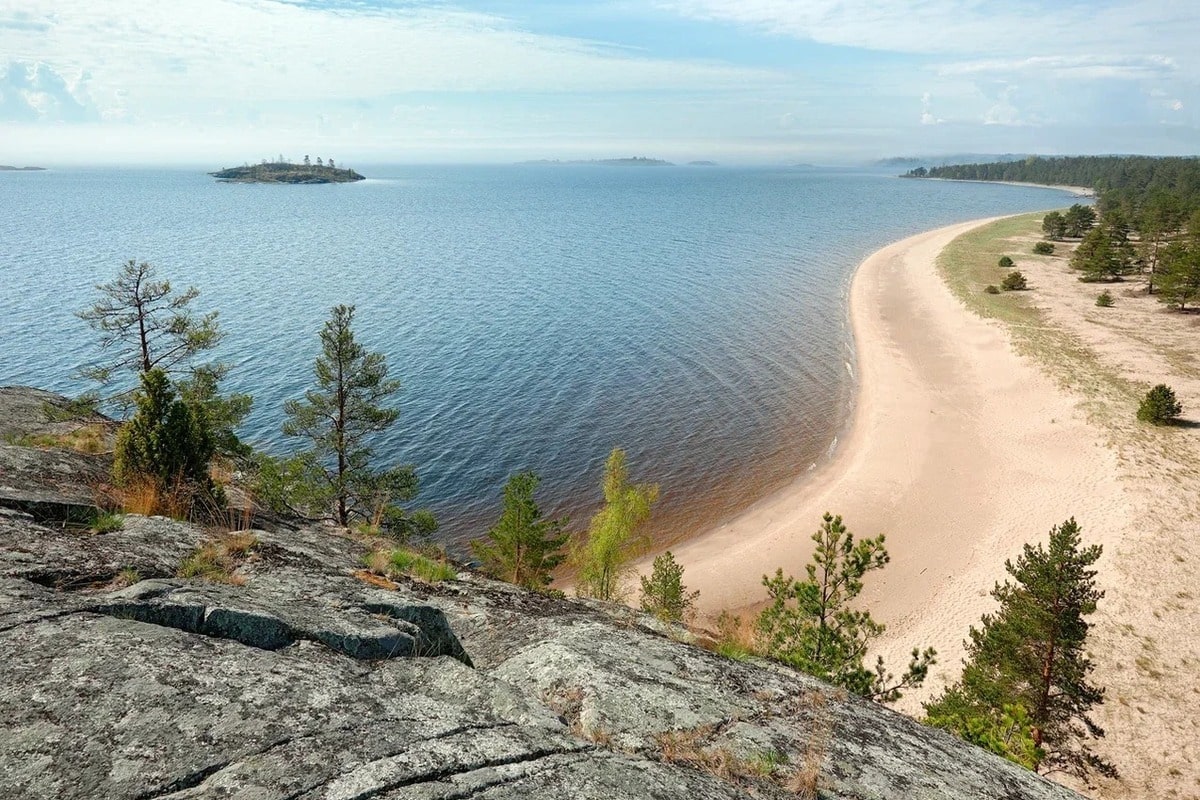Lake Ladoga is one of the largest and most famous bodies of water in Europe, admired for centuries for its beauty and its importance to history and nature. Located in northwestern Russia, it is considered unique not only because of its size but also due to its remarkable biodiversity. For centuries this lake served as an important trade and strategic hub connecting different peoples. Today it attracts researchers, tourists, and everyone fascinated by natural wonders. Here are some captivating facts about Lake Ladoga that you might not know.
- Lake Ladoga is the largest freshwater lake in Europe. Its surface area exceeds 17,000 square kilometers. In terms of size, it is larger than some small countries, such as Montenegro.
- The lake stretches about 220 kilometers in length and over 80 kilometers in width. Its average depth is around 50 meters, while the deepest points reach more than 200 meters. These dimensions make it resemble an inland sea.
- More than 50 rivers and streams flow into Lake Ladoga. The largest of them are the Svir, the Volkhov, and the Vuoksa. The only large river flowing out is the Neva, which connects the lake to the Gulf of Finland.
- The lake contains more than 600 islands. The most famous are Valaam and Konevets, both home to ancient monasteries. Many islands are covered with forests and preserve untouched nature.
- The water in Lake Ladoga is very clean thanks to numerous inflows and relatively low industrial pollution. It is suitable for drinking after minimal filtration. This makes the lake a crucial source of fresh water for St. Petersburg.
- The lake has glacial origins. It was formed about ten thousand years ago after the retreat of glaciers. This explains its vast size and uneven bottom.
- Lake Ladoga is rich in flora and fauna. More than 50 species of fish live here, including pike perch, pike, salmon, and the rare Ladoga seal. Dense coniferous forests surround the lake.
- The Ladoga seal is a unique species of freshwater seal. It adapted to life in the lake after the glacial period. This is one of the very few examples of seals living in fresh water.
- The climate around the lake is harsh, especially in winter. Ladoga freezes from December to April, with ice thickness exceeding one meter. This allows transportation across the frozen surface.
- During World War II, Lake Ladoga played a crucial role in saving Leningrad. The famous Road of Life ran across it, delivering food and fuel to the besieged city. This route operated even in winter across the ice.
- The lake is often called the northern sea because of its waves. On windy days, they can reach heights of 4–5 meters. This makes navigation on Ladoga rather dangerous.
- Several protected areas exist around the lake. They safeguard unique nature, birds, and rare plants. Ladoga is part of the international system of wetlands conservation.
- The Valaam Archipelago, located in the northern part of the lake, is famous for its rocky landscapes. It is home to an ancient monastery founded in the 10th century. Today it remains one of the most significant pilgrimage sites in Russia.
- The lake often changes its color depending on the weather. On sunny days the water looks blue, while on cloudy days it becomes dark. This gives the impression that Ladoga has many different faces.
- Archaeologists have found ancient human settlements along its shores. Finno-Ugric tribes lived here as early as the Stone Age. This proves the long history of human presence in the region.
- Fogs frequently occur over the lake. They form because of temperature differences between the water and the air. These fogs complicate navigation and add an aura of mystery.
- Ladoga is an important tourist center. It attracts not only pilgrims but also enthusiasts of fishing, sailing, and eco-tourism. Trips to the islands and monasteries are especially popular.
- The lake has strategic significance for transportation. It forms part of the waterways connecting the Baltic Sea with Russia’s internal rivers. This makes Ladoga a vital link in the country’s water system.
- Numerous legends and tales are associated with the lake. Locals tell stories about mysterious spirits and miracles that occurred on its islands. These stories give Ladoga a mystical character.
- Today Ladoga is a popular subject of scientific research. Scientists study climate change, ecology, and biodiversity here. The lake is often described as a natural laboratory.
- Some parts of the lake contain underwater rocks that are dangerous for ships. Sailors have long tried to avoid these places. Today detailed navigation maps ensure safety.
- Lake Ladoga is frequently mentioned in literature and music. Its beauty has been praised by poets and artists of different eras. This makes it not only a natural but also a cultural symbol.
- Storms on the lake can be as violent as those at sea. Fishermen say that during such times Ladoga resembles a real ocean. These weather conditions require great caution and experience.
Lake Ladoga is a unique natural phenomenon that combines beauty, history, and the richness of life. Each of these interesting facts highlights its diversity and importance for both people and nature. Fascinating facts prove that this body of water deserves careful protection and respect. You might not have known many of these details, but now the image of Ladoga appears even more vivid and impressive.





